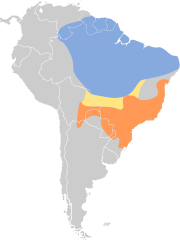Harpagus (bird)
| Harpagus | |
|---|---|

| |
| Double-toothed kite (Harpagus bidentatus) | |
| Scientific classification | |
| Domain: | Eukaryota |
| Kingdom: | Animalia |
| Phylum: | Chordata |
| Class: | Aves |
| Order: | Accipitriformes |
| Family: | Accipitridae |
| Subfamily: | Harpaginae |
| Genus: | Harpagus Vigors, 1824 |
| Type species | |
| Falco bidentatus[1] Latham, 1790
| |
| Species | |
Harpagus is a genus of birds of prey in the family Accipitridae. It comprises:
| Common name | Scientific name and subspecies | Range | Size and ecology | IUCN status and estimated population |
|---|---|---|---|---|
| Double-toothed kite | Harpagus bidentatus (Latham, 1790) Two subspecies
|
Belize, Bolivia, Brazil, Colombia, Costa Rica, Ecuador, El Salvador, French Guiana, Guatemala, Guyana, Honduras, Mexico, Nicaragua, Panama, Peru, Suriname, Trinidad and Tobago, and Venezuela
|
Size: Habitat: Diet: |
LC
|
| Rufous-thighed kite | Harpagus diodon (Temminck, 1823) |
Brazil, Paraguay and eastern Bolivia ; winters north to the Amazon basin and the Guyana Shield
|
Size: Habitat: Diet: |
LC
|
Both live in tropical American forest. They are small, rather accipiter-like kites, 30 to 35 cm long and compact, with long tails and oval wings ("pinched in" near the base of the trailing edge) which they characteristically curve downward when soaring or gliding. Both have dark tails with pale bars, as well as a white throat with a dark stripe down the middle. Another shared feature is a blunt bill with two notches on each side of the upper mandible. This "double tooth" gave rise not only to the common name of one species but to the specific epithets bidentatus and diodon. Both like rather high perches in trees and sometimes soar above the forest.
Harpagus was the Greek name of a Median general.
References
[edit]- ^ "Accipitridae". aviansystematics.org. The Trust for Avian Systematics. Retrieved 2023-07-26.
- Hilty, Steven L. (2003). Birds of Venezuela. Princeton University Press. pp. 229–230. ISBN 0-691-09250-8.
- Howell, Steve N. G.; Webb, Sophie (1995). A Guide to the Birds of Mexico and Northern Central America. Oxford University Press. pp. 183. ISBN 0-19-854012-4.
- Peterson, Alan P. (Editor). 1999. Zoological Nomenclature Resource (Zoonomen). Accessed 2007-08-22.





